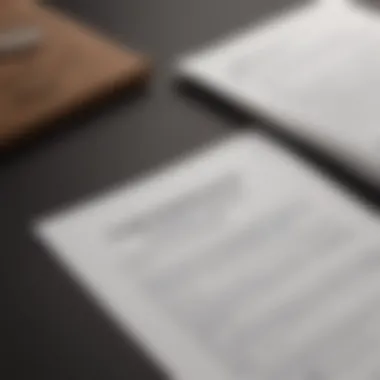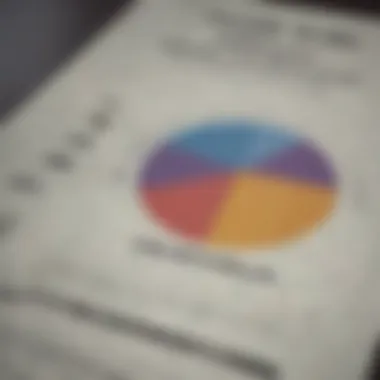Comprehensive Guide to Writing a Credit Dispute Letter


Intro
A credit report is a crucial element in maintaining financial health. Errors in this report can lead to significant consequences, including higher interest rates or loan denials. Recognizing the importance of accurate credit reporting is essential for anyone seeking to manage their finances effectively.
Disputing inaccuracies is often the first step to correcting these issues. This guide provides a structured approach to writing a dispute letter. It emphasizes the need for careful attention to detail and clarity in communication with credit reporting agencies.
With the right knowledge, individuals can help ensure that their credit reports accurately reflect their financial condition. This involves understanding what credit status means, recognizing common errors, and mastering the art of dispute letters.
Understanding Credit Status
What is Credit Status?
Credit status refers to an individual's creditworthiness as reflected in their credit report. It encompasses all credit-related activities and information, including payment history, credit utilization, and types of credit. Accurate assessment of credit status is crucial for lenders when determining eligibility for loans or credit.
Key Factors Affecting Credit Scores
Several factors influence credit scores:
- Payment History: Timely payments positively impact your score.
- Credit Utilization: This refers to the ratio of your credit card balances to credit limits. Lower ratios are better.
- Length of Credit History: Longer histories can enhance your score.
- Types of Credit: A mix of accounts, such as credit cards and installment loans, is advantageous.
- Recent Inquiries: Multiple inquiries can negatively affect your score as it indicates risk.
Importance of Knowing Your Credit Reports
Understanding your credit report allows you to monitor your financial status effectively. You can identify errors that could hurt your creditworthiness, making it essential to review your report regularly.
How to Obtain Your Credit Reports
In the United States, individuals are entitled to one free credit report each year from the three main credit bureaus: Equifax, Experian, and TransUnion. You can obtain your reports from AnnualCreditReport.com.
Writing the Dispute Letter
This is a pivotal part of the process. It is essential to be concise and factual. Clearly outline the inaccuracies found in your credit report and provide supporting documents whenever possible.
Essential Components of a Dispute Letter
A dispute letter should include:
- Your contact information: Name, address, and phone number.
- A clear statement of your dispute: Indicate what's wrong.
- Supporting documentation: Attach copies of relevant documents.
- A request for correction: Ask the bureau to fix the error.
- A signature: Ensure it is signed to authenticate the document.
Actionable Insights and Next Steps
Once you have sent the dispute letter, keep records of all communications. Monitor your credit report for updates. Continuous learning about your credit status helps maintain financial well-being and ensures that your credit report reflects true financial history.
Regular monitoring allows you to catch potential issues early and act promptly to resolve them. Furthermore, setting clear financial goals will help you maintain and improve your credit score more effectively.
Understanding Credit Reports
When navigating the financial landscape, understanding credit reports is crucial. These reports serve as a summary of an individual’s credit history. They provide insights to lenders, landlords, and even employers about a person's financial behavior. An accurate credit report can have a significant influence on your ability to borrow money, secure housing, and obtain certain jobs. It is essential to comprehend what constitutes a credit report and the implications of any inaccuracies present within it.
What is a Credit Report?
A credit report is a detailed record of an individual’s credit activity. It includes personal information, such as name, address, date of birth, and Social Security number, as well as accounts held by the individual, payment history, and any bankruptcies or delinquencies. Credit reports are compiled by credit bureaus like Experian, TransUnion, and Equifax. These agencies collect information from various sources, including financial institutions and public records, to create a comprehensive overview of an individual's creditworthiness.
Importance of Accurate Credit Reporting
Accurate credit reporting is vital for both consumers and lenders. For consumers, a clean credit report boosts chances of loan approval at favorable terms. Errors in a credit report can lead to denial of credit or increased interest rates. Lenders, on the other hand, utilize credit reports to assess the risk of lending to a borrower. If a report contains misinformation, it can skew the lender’s assessment, potentially resulting in financial loss.
Inaccuracies can also affect rental applications and employment opportunities. Therefore, it is in everyone’s interest to ensure their credit report is accurate, which will protect and enhance financial health.
Common Errors Found in Credit Reports
Errors in credit reports are not uncommon. Here are some prevalent mistakes:


- Incorrect Personal Information: This may include misspellings of names or wrong addresses, which can confuse creditors about your identity.
- Account Errors: Accounts that don't belong to you, or outdated information about closed accounts can appear on your report.
- Payment Mistakes: There may be reports of late payments which were actually paid on time.
- Duplicate Accounts: Sometimes, accounts might be listed multiple times.
Being aware of these common errors is the first step in maintaining an accurate credit profile. Regularly reviewing credit reports for inaccuracies can help mitigate potential issues, ensuring a healthier financial future.
Legal Framework for Credit Reporting
Understanding the legal framework surrounding credit reporting is crucial for anyone engaging with their credit report, especially when it comes to disputing inaccuracies. The legal structure provides protections and outlines procedures that ensure consumers can monitor and maintain their credit histories. This framework is essential as it not only sets the standards for credit reporting agencies but also informs consumers of their rights. Without this knowledge, disputes may lack proper grounds, leading to ineffective outcomes.
Fair Credit Reporting Act Overview
The Fair Credit Reporting Act, often abbreviated as FCRA, is a key piece of legislation that governs how credit information is collected, distributed, and utilized. Enacted in 1970, the FCRA aims to promote accuracy and fairness in consumer reporting. Its significance cannot be overstated, as it establishes the legal principles that financial institutions and credit bureaus must adhere to.
The FCRA requires that credit reporting agencies conduct reasonable investigations into disputes. If a consumer identifies an error in their credit report, they have the right to challenge the information. The agency must then verify the data, ensuring that incorrect information is rectified promptly. Failure to comply with these regulations can lead to financial penalties for the credit reporting agencies.
Moreover, the FCRA mandates that consumers are entitled to access their credit reports on request. This transparency allows individuals to monitor their credit standing and address any potential inaccuracies proactively. By knowing this, one can see the direct link between understanding the FCRA and effectively disputing errors.
Consumer Rights Under the FCRA
Under the FCRA, consumers possess specific rights that protect them during the credit reporting process. These rights are pivotal for anyone seeking to correct their credit reports, as they provide a framework for action.
- Right to Access: Every consumer has the right to request and obtain a copy of their credit report from all three major credit bureaus: Experian, Equifax, and TransUnion. This access is especially important for identifying errors.
- Right to Dispute: If a consumer finds inaccuracies, they have the right to dispute the information. Credit bureaus are obligated to investigate the claims and respond within a reasonable period, typically thirty days.
- Right to Accurate Information: Consumers are entitled to maintain credit reports that only reflect accurate and complete information. If inaccuracies are found, they can demand correction.
- Right to Awareness of Credit Inquiries: Frequent inquiries into a consumer’s credit can negatively impact their score. Under the FCRA, consumers must be notified if their credit report is used against them in a decision such as credit denial.
In addition to these rights, it is essential to note that consumers can also seek damages if they face violations of the FCRA. Knowing these rights equips individuals with the necessary tools to effectively navigate the dispute process, leading to healthier credit management.
Understanding the FCRA and your rights under it is central to successfully disputing errors on your credit report. Stay informed and proactive.
Preparing to Write a Dispute Letter
Writing a dispute letter is a precise task that requires careful preparation. Each element plays a significant role in ensuring that your effort yields a favorable outcome. In this section, we delve into the critical components of preparing to write a dispute letter. The quality of your letter greatly influences the response from credit reporting agencies. Understanding this can provide you substantial informational leverage.
Identifying the Errors
The first step in preparing a dispute letter is identifying the errors present in your credit report. You should conduct a thorough examination of your credit report before drafting the letter. Errors can manifest in different forms, including:
- Incorrect personal information: This includes misspelled names, wrong addresses, or incorrect dates of birth.
- Account discrepancies: Sometimes accounts that do not belong to you may inadvertently appear.
- Incomplete or outdated information: This pertains to accounts that have been settled or paid off but still show as outstanding.
To pinpoint these inaccuracies, it is vital to obtain a copy of your credit report. You can request a free report annually from each major bureau: Equifax, Experian, and TransUnion. Scrutinize this document closely. If you find any discrepancies, note them down. Being specific about the errors will make your letter more effective.
Gathering Supporting Documents
Once errors have been identified, the next step is gathering supporting documents. Solid evidence enhances the validity of your claims and strengthens your case. You should collect documentation that corroborates your position, such as:
- Previous correspondence: Any communication you had with creditors regarding the disputed entries.
- Payment receipts: If a bill is marked as unpaid or overdue, receipts showing payment help in your arguments.
- Affidavits or statements: Statements from third parties, like landlords or lenders, affirming your claims can be useful.
Organizing these documents systematically is vital. Label them clearly and ensure they are easy to reference when you write your letter. Proper documentation supports your statements and underscores the urgency of correcting the report.
By meticulously identifying errors and gathering necessary documents, you prepare a strong foundation for your dispute letter. This preparation lays the groundwork for a more persuasive appeal to the credit bureaus.
Components of an Effective Dispute Letter
Writing a dispute letter requires consideration of various components that enhance its effectiveness. A clear structure not only conveys the message effectively but also improves the chances of a favorable outcome. The elements we will discuss— the introduction, stating the dispute clearly, citing evidence, and requesting resolution— are critical in ensuring that your letter is taken seriously by the credit bureau.
Prelims of the Letter
The introduction sets the tone for the whole letter. It should be brief yet clear. In this part, you must identify yourself and explain the purpose of your letter. Provide your full name, address, and contact information. Include the date you are writing the letter as well. This makes it easy for the reader to track your correspondence. Additionally, reference your credit report by stating which agency you are addressing. A simple, direct opening usually suffices:
"I am writing to dispute an error on my credit report provided by [Credit Bureau Name]."
This introduction is effective because it quickly informs the agency of your intent.
Clearly Stating the Dispute
Once you’ve set the stage with the introduction, the next step is to specify the error. Clearly state what the inaccuracy is and why it is erroneous. Be specific. Include the account number and any relevant details that pinpoint the dispute. For example:


- “The account showing past due payments is incorrect.”
- “Account number 1234567 is a duplicate entry.”
Be direct and factual. Avoid emotional language; factual clarity is what drives resolution.
Citing Attached Evidence
The success of your dispute often relies on the documentation you provide. Attach all relevant evidence that supports your claim. This may include copies of bills, statements, or anything else that can substantiate your argument. Clearly reference each document within the letter. Consider formatting this section as a list:
- Copy of my payment records showing on-time payment.
- Correspondence from [Lender/ Company] confirming the error.
By citing attached evidence in this way, you create a clear link between your claims and the documents, making it simpler for the agency to validate your dispute.
Requesting a Resolution
Finally, conclude your letter with a clear request for resolution. Specify what action you want the credit bureau to take. Examples may include:
- “Please correct the information on my credit report.”
- “I would appreciate a prompt investigation into this matter.”
This closing reinforces the purpose of your letter and sets clear expectations. Make sure to thank them for their attention to the matter and provide a way for them to contact you with questions. Being polite, yet firm, can influence their willingness to assist.
By addressing each of these components methodically, you create a structured and effective dispute letter that clearly reflects your intent and supports your claims. This is crucial in navigating the sometimes complex landscape of credit reporting and dispute resolution.
Sample Dispute Letter
Writing a dispute letter is a crucial step in rectifying inaccuracies in your credit report. This section aims to illuminate the relevance of having a well-crafted sample dispute letter. Providing a structured template not only saves time but also ensures that essential elements are included. Without a proper format, one might miss important details, which could delay the dispute process.
Format and Structure of the Sample Letter
The format of your dispute letter is essential for clarity and professionalism. It should begin with your contact information at the top, followed by the date, and then the recipient's information. A clear subject line is needed to indicate the purpose of the letter.
The body should contain the following components:
- Introduction: State who you are and the reason for your writing.
- Description of the Error: Clearly explain what the error is, including account numbers and dates of the transactions.
- Supporting Evidence: Mention any attached documents that support your claim.
- Conclusion: Request specific action you want the credit bureau to take, such as removing or correcting the information.
A well-organized letter helps the credit bureau to process your request swiftly. Structure conveys reason, which can expedite resolution.
Drafting Your Own Letter Based on the Sample
Drafting your own letter can be made significantly easier by using a sample as a guide. First, customize the introduction to reflect your personal information accurately. Next, ensure the details regarding the error are specific. Avoid general statements; precision is key.
Incorporate the evidence you are attaching, referencing it in the letter. Be sure to include the request for a resolution clearly at the end. This will prevent any confusion about your expectations from the credit bureau.
Make certain to proofread for any typographical mistakes. Even minor errors can detract from the professionalism of your appeal.
In summary, by following the sample structure and ensuring your letter is tailored to reflect your unique situation, you enhance the chances of a favorable outcome.
Submitting the Dispute Letter
Submitting a dispute letter is a critical step in the process of addressing inaccuracies in your credit report. This action not only initiates the investigation but also sets the stage for rectifying any misleading information that could negatively impact your financial standing. Understanding the proper procedure for submission ensures that your dispute is heard and considered in a timely manner. Additionally, it maximizes the likelihood of a successful resolution.
Where to Send Your Dispute Letter
Selecting the correct recipient for your dispute letter is paramount. Most often, the letter should be directed to the credit bureau reporting the incorrect information. The three major credit bureaus are Equifax, Experian, and TransUnion. Each has its address for receiving disputes, and using the right one speeds up your submission process. Here are the addresses for each bureau:
- Equifax: P.O. Box 740256, Atlanta, GA 30374
- Experian: P.O. Box 4500, Allen, TX 75013
- TransUnion: P.O. Box 2000, Chester, PA 19016
Verify the addresses on the bureaus' websites to ensure accuracy. Sending your letter to an incorrect location can delay the entire process.
Recommended Submission Methods
It is essential to choose an effective submission method to ensure that your dispute letter reaches the intended recipient. Here are some recommended methods:
- Certified Mail: Using certified mail with a return receipt requested provides you with proof of delivery. This is crucial if you need to follow up later.
- Online Submission: Some credit bureaus allow you to submit disputes through their online portals. This method can sometimes expedite the process, but adherence to their guidelines is necessary.
- Fax: While less common, faxing your dispute can also be an option for some bureaus. Be sure to keep a copy of the submission as a record.


Before submitting, double-check the specific requirements of each bureau. Different agencies may have unique submission guidelines or forms that should be included with the letter.
Important: Always keep copies of your dispute letter and any supporting documentation you send. This record can be invaluable if your dispute requires escalation or further follow-up.
What to Expect After Submission
After you have submitted your dispute letter, it is crucial to understand the next steps that will unfold. This section will provide insight into the investigation process conducted by the credit bureau and the typical timeline for their responses. Awareness of these elements can help set realistic expectations and prepare you for potential outcomes.
Investigation Process by the Credit Bureau
Once your dispute letter reaches the credit bureau, they initiate an investigation. This process typically involves reviewing the information you've provided alongside the data in your credit file. The credit bureau will also reach out to the creditor that reported the disputed information to obtain details regarding the accuracy of that entry.
The key points of the investigation process include:
- Verification: The credit bureau verifies if the disputed information is accurate or not.
- Timeline: They are required to complete the investigation within 30 days of receiving your dispute.
- Documentation Review: Your supporting documents will be assessed to ascertain the validity of your claim.
It is important to note that the credit bureau does not decide the eligibility of the credit entry; they serve as a mediator between you and the information provider. Hence, ensuring your documents are clear and concise will aid their ability to make an informed decision.
"Understanding the investigation process gives you a powerful tool in managing your credit effectively."
Timeline for Response
Following your submission, the credit bureau typically has a clear timetable to adhere to. Within 30 days from the date of receipt of your dispute, you should expect a response.
The timeline can be outlined as follows:
- Day 1: Your dispute is received, and the clock starts ticking.
- Days 1-30: The investigation occurs. This involves communication with the creditor along with a review of your documents.
- By Day 30: You will receive the results of the investigation.
If the credit bureau determines that the information was inaccurate, they will take action to correct your credit report. You will also receive a copy of your updated credit report, which reflects the changes. In cases where the information is found to be accurate, the organization will inform you as well, often including an explanation.
Considerations: Always follow up if you do not receive a response within the expected timeframe. This can help ensure your dispute is being processed timely and that your credit report reflects accurate information.
Follow-Up Actions
Following up after submitting your dispute letter is a crucial step in ensuring that your concerns about inaccuracies on your credit report are properly addressed. Many individuals overlook this phase, believing that sending the letter alone is sufficient. However, proactive engagement can significantly enhance the likelihood of a satisfactory resolution.
Responding to the Investigator's Findings
Once the credit bureau has conducted its investigation, you will receive a response detailing the findings. It’s essential to carefully review this communication. The results may confirm the error, thus leading to a correction, or they might uphold the inaccurate information. If the latter occurs, you have the right to express your disagreement with the findings.
To respond effectively, consider the following steps:
- Document Your Response: Keep a clear, written record of the findings, which is essential for any potential disputes down the line.
- Gather Additional Evidence: If you believe the investigation did not adequately address your concerns, compile new evidence to support your case.
- Prepare a Formal Response: Articulate your reasons for disputing the findings, referencing any supporting documents you gathered. Make sure your response is concise and to the point.
By taking these steps, you not only maintain control over the situation but also demonstrate to the credit bureau the seriousness of your claim.
Next Steps if the Dispute is Unresolved
If the investigation does not resolve your dispute to your satisfaction, there are further actions you can take. Consider the following options:
- File a Complaint with the Consumer Financial Protection Bureau (CFPB): If you feel your dispute has not been handled fairly, submit a complaint through the CFPB. They can mediate between you and the credit bureau.
- Contact the Creditor Directly: Occasionally, the credit bureau may side with the creditor. Reach out to the creditor in question to discuss the error directly. Provide them with your evidence and request a review.
- Add a Consumer Statement: You can place a statement on your credit report explaining the dispute. This statement can provide context for future lenders reviewing your report.
- Seek Legal Advice: In persistent cases where you continue to experience issues, consulting with a lawyer specializing in consumer rights may help you understand your options and rights.
Finale
Writing a dispute letter for your credit report is not just a minor task; it is a critical component of maintaining your financial integrity. This article has made it clear that inaccuracies on your credit report can have significant ramifications on your ability to secure loans, obtain favorable interest rates, or even get a job, as many employers perform credit checks.
Recap of Key Points
In summary, some essential points to recall from this guide include:
- Understanding Credit Reports: Having a solid grasp of what credit reports are and their significance.
- Legal Framework: Knowing the Fair Credit Reporting Act can empower you in your right to dispute inaccuracies.
- Identifying Errors: Carefully scrutinizing your credit report helps you catch mistakes that can be fixed easily.
- Effective Letter Structure: Understanding the components of a well-crafted dispute letter can significantly improve the chances of a favorable resolution.
- Follow-Up Actions: Being proactive after submitting the letter ensures that your dispute is taken seriously and addressed in a timely manner.
These aspects not only help in rectifying your credit history but also promote better credit management practices.
Encouragement for Proactive Credit Management
Proactive credit management is not just about fixing current errors; it is about establishing a healthy financial future. Regularly monitoring your credit report helps you identify issues before they become larger problems. For this reason, I encourage all readers to periodically check their credit reports and understand the factors affecting their credit scores.
Additionally, educating yourself about financial health enhances your ability to make informed decisions regarding credit, loans, and other financial products. Taking charge of your credit report can lead to better financial outcomes and peace of mind. As a credit management learner or someone looking to improve your financial health, utilizing the steps outlined herein will serve you well not only in disputing errors but also in cultivating long-term creditworthiness.







